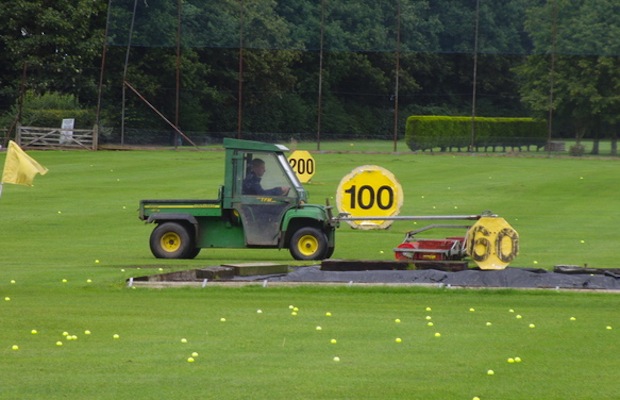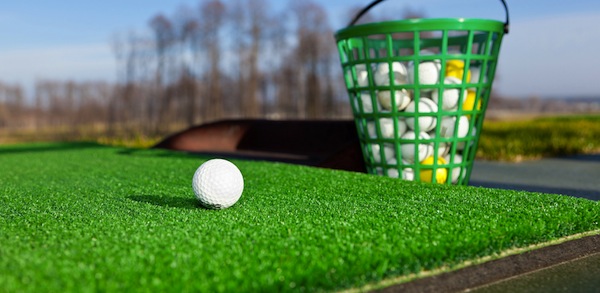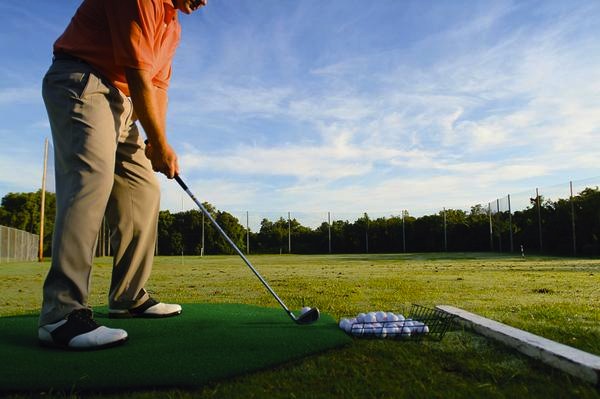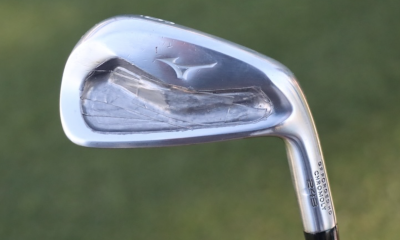Instruction
Take your range game to the course with this practice routine

I constantly come across golfers who tell me something along the lines of “I hit it great on the range, but I can’t do it on the course!” So, what’s really going on here and how can you start to transfer your range game to the golf course?
Let’s start by looking at the main difference between the range and the course.
- You no longer have perfect lies.
- Your bad shots actually count.
- You rarely ever hit the same club twice in a row, let alone at the same target.
- You are playing with other people.
- You have time in between your shots.
Let’s say the average time golfers spend at the range is about 45 minutes. In those 45 minutes, they’re usually able to hit about 50 balls. On the course, however, golfers only hit between 40 and 80 shots over 4-to-6 hours.
The moral of the story is that you will get better results from practice that is more like what you do on the course. If you practice anything like the average golfer that I see on the range, guess what? You’re only preparing yourself to get better at repetitively hitting balls on the range.
Practice Routine
Practice routines have been written about at length on GolfWRX, but here is one I enjoy that you might not have heard about. It works regardless of what specific improvements you’re trying to make in your swing.
It has a total of 10 levels. You need to be able to produce a success rate of 80 percent (4 out of 5 shots) until they can go onto the next level. Success is defined as hitting what you consider to be a “good” shot. You have to choose what the parameters are for a “good” shot beforehand, depending on what you’re working on and your current skill level.
How you score it
- 5/5 — move up a level
- 4/5 — move up a level
- 3/5 — stay at current level
- 2/5 — move down a level
- 1/5 — move down a level
Levels
- Level 1: Same club, same target (1/2 swing) (ex: white flag)
- Level 2: Same club, same target (3/4 swing) (ex: white flag)
- Level 3: Same club, same target (Full swing) (ex: white flag)
- Level 4: Same club, different targets (ex: white flag, blue flag, red flag, etc.)
- Level 5: Different clubs, same target (ex: white flag)
- Level 6: Different clubs, different targets (ex: white flag, blue flag, red flag, etc.)
- Level 7: Different clubs, different targets, missing on a certain side (right or left)
- Level 8: Different clubs, different targets, changing lies or trajectory.
- Level 9: Different clubs, different targets with routine.
- Level 10: Ready for expectations of seeing results on course.
Other practice ideas
Since you have time in between your shots on the course, why not practice for it? When you are on the range, hit a shot and wait a few minutes before hitting the next shot. Repeat this with the levels above if possible.
A lot of people I see have a “favorite” spot on the range, which is where they hit the majority of their practice balls. I would suggest hitting balls from different spots on the range, because again, hitting from the same spot does not mimic a round of golf.
If possible, I would even break up your practice session so that you hit from different places. So if you get 75 balls, hit 25 from a spot on the left of the range, 25 from the center and 25 from a spot on the right. That’s a littler closer to what you get on the course. Until you see some good results on the range while going through these levels, you should not expect improved results on the golf course.
My general rule of thumb for working on something in your swing is to spend a minimum of 15 minutes per day doing the move. You don’t need to be hitting balls (although that is a bonus). You just need a club in your hand or to simply move your body in the way you and your coach talked about.
Everyone can improve at golf. It requires the same amount of time and preparation as any other skill and needs to be developed and honed before it can be mastered. Prepare yourself the best you can and be realistic about your expectations. And if you can’t get to level 10 on the range, you shouldn’t expect to play a level 10-type round on the course!
- LIKE55
- LEGIT17
- WOW9
- LOL5
- IDHT4
- FLOP4
- OB4
- SHANK5
Instruction
The Wedge Guy: The easiest-to-learn golf basic

My golf learning began with this simple fact – if you don’t have a fundamentally sound hold on the golf club, it is practically impossible for your body to execute a fundamentally sound golf swing. I’m still a big believer that the golf swing is much easier to execute if you begin with the proper hold on the club.
As you might imagine, I come into contact with hundreds of golfers of all skill levels. And it is very rare to see a good player with a bad hold on the golf club. There are some exceptions, for sure, but they are very few and very far between, and they typically have beat so many balls with their poor grip that they’ve found a way to work around it.
The reality of biophysics is that the body moves only in certain ways – and the particulars of the way you hold the golf club can totally prevent a sound swing motion that allows the club to release properly through the impact zone. The wonderful thing is that anyone can learn how to put a fundamentally sound hold on the golf club, and you can practice it anywhere your hands are not otherwise engaged, like watching TV or just sitting and relaxing.
Whether you prefer an overlap, interlock or full-finger (not baseball!) grip on the club, the same fundamentals apply. Here are the major grip faults I see most often, in the order of the frequency:
Mis-aligned hands
By this I mean that the palms of the two hands are not parallel to each other. Too many golfers have a weak left hand and strong right, or vice versa. The easiest way to learn how to hold the club with your palms aligned properly is to grip a plain wooden ruler or yardstick. It forces the hands to align properly and shows you how that feels. If you grip and re-grip a yardstick several times, then grip a club, you’ll see that the learning curve is almost immediate.
The position of the grip in the upper/left hand
I also observe many golfers who have the butt of the grip too far into the heel pad of the upper hand (the left hand for right-handed players). It’s amazing how much easier it is to release the club through the ball if even 1/4-1/2″ of the butt is beyond the left heel pad. Try this yourself to see what I mean. Swing the club freely with just your left hand and notice the difference in its release from when you hold it at the end of the grip, versus gripping down even a half inch.
To help you really understand how this works, go to the range and hit shots with your five-iron gripped down a full inch to make the club the same length as your seven-iron. You will probably see an amazing shot shape difference, and likely not see as much distance loss as you would expect.
Too much lower (right) hand on the club
It seems like almost all golfers of 8-10 handicap or higher have the club too far into the palm of the lower hand, because that feels “good” if you are trying to control the path of the clubhead to the ball. But the golf swing is not an effort to hit at the ball – it is a swing of the club. The proper hold on the club has the grip underneath the pad at the base of the fingers. This will likely feel “weak” to you — like you cannot control the club like that. EXACTLY. You should not be trying to control the club with your lower/master hand.
Gripping too tightly
Nearly all golfers hold the club too tightly, which tenses up the forearms and prevents a proper release of the club through impact. In order for the club to move back and through properly, you must feel that the club is controlled by the last three fingers of the upper hand, and the middle two fingers of the lower hand. If you engage your thumbs and forefingers in “holding” the club, the result will almost always be a grip that is too tight. Try this for yourself. Hold the club in your upper hand only, and squeeze firmly with just the last three fingers, with the forefinger and thumb off the club entirely. You have good control, but your forearms are not tense. Then begin to squeeze down with your thumb and forefinger and observe the tensing of the entire forearm. This is the way we are made, so the key to preventing tenseness in the arms is to hold the club very lightly with the “pinchers” — the thumbs and forefingers.
So, those are what I believe are the four fundamentals of a good grip. Anyone can learn them in their home or office very quickly. There is no easier way to improve your ball striking consistency and add distance than giving more attention to the way you hold the golf club.
More from the Wedge Guy
- The Wedge Guy: Golf mastery begins with your wedge game
- The Wedge Guy: Why golf is 20 times harder than brain surgery
- The Wedge Guy: Musings on the golf ball rollback
- LIKE83
- LEGIT13
- WOW4
- LOL1
- IDHT0
- FLOP4
- OB1
- SHANK8
Instruction
Clement: Stop ripping off your swing with this drill!

Not the dreaded headcover under the armpit drill! As if your body is defective and can’t function by itself! Have you seen how incredible the human machine is with all the incredible feats of agility all kinds of athletes are accomplishing? You think your body is so defective (the good Lord is laughing his head off at you) that it needs a headcover tucked under the armpit so you can swing like T-Rex?
- LIKE0
- LEGIT1
- WOW2
- LOL0
- IDHT0
- FLOP0
- OB0
- SHANK2
Instruction
How a towel can fix your golf swing

This is a classic drill that has been used for decades. However, the world of marketed training aids has grown so much during that time that this simple practice has been virtually forgotten. Because why teach people how to play golf using everyday items when you can create and sell a product that reinforces the same thing? Nevertheless, I am here to give you helpful advice without running to the nearest Edwin Watts or adding something to your Amazon cart.
For the “scoring clubs,” having a solid connection between the arms and body during the swing, especially through impact, is paramount to creating long-lasting consistency. And keeping that connection throughout the swing helps rotate the shoulders more to generate more power to help you hit it farther. So, how does this drill work, and what will your game benefit from it? Well, let’s get into it.
Setup
You can use this for basic chip shots up to complete swings. I use this with every club in my bag, up to a 9 or 8-iron. It’s natural to create incrementally more separation between the arms and body as you progress up the set. So doing this with a high iron or a wood is not recommended.
While you set up to hit a ball, simply tuck the towel underneath both armpits. The length of the towel will determine how tight it will be across your chest but don’t make it so loose that it gets in the way of your vision. After both sides are tucked, make some focused swings, keeping both arms firmly connected to the body during the backswing and follow through. (Note: It’s normal to lose connection on your lead arm during your finishing pose.) When you’re ready, put a ball in the way of those swings and get to work.

Get a Better Shoulder Turn
Many of us struggle to have proper shoulder rotation in our golf swing, especially during long layoffs. Making a swing that is all arms and no shoulders is a surefire way to have less control with wedges and less distance with full swings. Notice how I can get in a similar-looking position in both 60° wedge photos. However, one is weak and uncontrollable, while the other is strong and connected. One allows me to use my larger muscles to create my swing, and one doesn’t. The follow-through is another critical point where having a good connection, as well as solid shoulder rotation, is a must. This drill is great for those who tend to have a “chicken wing” form in their lead arm, which happens when it becomes separated from the body through impact.
In full swings, getting your shoulders to rotate in your golf swing is a great way to reinforce proper weight distribution. If your swing is all arms, it’s much harder to get your weight to naturally shift to the inside part of your trail foot in the backswing. Sure, you could make the mistake of “sliding” to get weight on your back foot, but that doesn’t fix the issue. You must turn into your trial leg to generate power. Additionally, look at the difference in separation between my hands and my head in the 8-iron examples. The green picture has more separation and has my hands lower. This will help me lessen my angle of attack and make it easier to hit the inside part of the golf ball, rather than the over-the-top move that the other picture produces.


Stay Better Connected in the Backswing
When you don’t keep everything in your upper body working as one, getting to a good spot at the top of your swing is very hard to do. It would take impeccable timing along with great hand-eye coordination to hit quality shots with any sort of regularity if the arms are working separately from the body.
Notice in the red pictures of both my 60-degree wedge and 8-iron how high my hands are and the fact you can clearly see my shoulder through the gap in my arms. That has happened because the right arm, just above my elbow, has become totally disconnected from my body. That separation causes me to lift my hands as well as lose some of the extension in my left arm. This has been corrected in the green pictures by using this drill to reinforce that connection. It will also make you focus on keeping the lead arm close to your body as well. Because the moment either one loses that relationship, the towel falls.


Conclusion
I have been diligent this year in finding a few drills that target some of the issues that plague my golf game; either by simply forgetting fundamental things or by coming to terms with the faults that have bitten me my whole career. I have found that having a few drills to fall back on to reinforce certain feelings helps me find my game a little easier, and the “towel drill” is most definitely one of them.
- LIKE12
- LEGIT1
- WOW2
- LOL0
- IDHT0
- FLOP2
- OB0
- SHANK8
-

 19th Hole2 weeks ago
19th Hole2 weeks agoJohn Daly stuns fans into silence with brutal opening tee shot on PGA Tour Champions
-

 19th Hole4 days ago
19th Hole4 days agoThings got heated at the Houston Open between Tony Finau and Alejandro Tosti. Here’s why
-

 19th Hole23 hours ago
19th Hole23 hours agoReport: Tiger Woods has ‘eliminated sex’ in preparation for the 2024 Masters
-

 19th Hole2 weeks ago
19th Hole2 weeks ago2-time major champ announces shock retirement from the sport at age of 33
-

 19th Hole2 weeks ago
19th Hole2 weeks agoCharlie Woods finds it tough going on American Junior Golf Association debut
-

 19th Hole2 weeks ago
19th Hole2 weeks agoEdoardo Molinari reveals the latest PGA Tour golfer to turn down ‘good offer’ from LIV Golf
-

 19th Hole3 weeks ago
19th Hole3 weeks agoScottie Scheffler had an interesting response when asked how he ‘quiets the noise’ following Players victory
-

 19th Hole2 weeks ago
19th Hole2 weeks agoJon Rahm dealt fresh blow to hopes of qualifying for 2025 Ryder Cup






















Mike
Jul 8, 2021 at 11:35 pm
Thank you for the many great recommendations and contributions. They will certainly help many people to become the golfer they want to be. There are a lot of programs out there. This service has helped me a lot: https://ezymoney.net/take-your-range-game-to-the-golf-course/ I’m sure this will help improve someone else’s game as well…
Mike
Aug 17, 2014 at 1:53 pm
I like the idea of levels. Measurable results and goals motivate me. Thanks for the article.
Rick
Jul 14, 2014 at 1:29 pm
A range session for me starts with the lofted clubs and works up through the bag getting in groove with each. But to simulate taking my range game to the course I play “holes” at the range. For example: Pick a target line and call this a 500 yard par 5. Hit driver. Did it fade, draw or straight line? What’s the leave? Hit that club next. Spot on with the target? If not pull a wedge and pick the appropriate spot. Play doglegs, par 3’s whatever, but the randomness of pulling clubs helps get me past having a great swing only on the 3rd or 4th ball.
RW
John
Jul 11, 2014 at 6:16 pm
Definitely will start to try to incorporate this. This season I’ve made a conscious effort to practice less and play more, and when I do practice, to make it as much like a round as possible, after a couple warm up wedges that is. One thing that has helped me a lot, which is similar to the “taking a break between swings” suggestion in the article, is that I make sure to go through my pre-shot routine before every swing on the range. It reinforces proper alignment, gets me in more of the mindset I’m in on the course, and it helps when I hit a stinker and need to clear my mind before I go into ‘mindless bashing’ mode.
Mathieu
Jul 11, 2014 at 10:11 am
The more you mechanise something on the range, the less solutions you will find on the course. these different practice routines show you to improve the way you practice on the range, it is really interesting. Never hit the same shot, as every shot on the course is unique in the choices you have to make to throw your ball where you want (different lie (ball and stance), wind,weather, target shape and size, visualization comfort, ball shape you should make, physical condition evolves during a round…).
a good way to make youself into a course situation on the range is also to play hole by hole in your mind (1rst drive then 8 iron to the green and so on), this is a good exercice before a competition.
this is not easy to get used to, before i had a habbit of repetition that was confortable, but i changed to creating differents shots as described in this article, and improved my average score a lot.
Sky
Jul 10, 2014 at 11:26 pm
What about those of us who play decent on the course, but suck on the range? I think this approach could work for us as well. I think my problem on the range is that I beat ball after ball without changing clubs or taking time between. I almost get into making swings on the range instead of hitting shots. Anyone else have thoughts on this?
Rich
Jul 11, 2014 at 6:21 am
Stop going to the range. Sounds like you don’t need it. Lucky you, just play golf dude!
Mathieu
Jul 11, 2014 at 9:47 am
right, you just stay on the course!, you are lucky to be playing golf just for the result, and you must adapt quickly to a golf shot situation . lucky you
Will T.
Jul 10, 2014 at 10:01 pm
Awesome stuff! Cant wait to try it out.
Steve
Jul 10, 2014 at 5:23 pm
Very misleading. This routine might be good for everyone who’s a 5 handicap or better, but anyone else should be working on groving a swing. Hit the same club 40 times, then hit a different one 40 times. If you can get to where you’re hitting 75-80% of those good, you can hit every club in your bag.
I might have to hit my ball out from under a tree once every 3 months out on the course, too, but that doesn’t mean I’m going to practice it on the range.
Richard
Jul 10, 2014 at 5:46 pm
Steve has no idea what he is talking about ^
KK
Jul 10, 2014 at 9:02 pm
Golf is a figurative moving target and we should practice as such. Once my friends and I start playing HORSE on the range, our range game starts to look very much like our course game. Haha.
DH14
Jul 11, 2014 at 9:53 am
I actually am a 5, and I think it’s a good routine…
The bigger issue is, Steve only hits out from under a tree once every THREE MONTHS? What a guy.
Pingback: Take your range game to the course with this practice routine | Spacetimeandi.com
Roger S.
Jul 10, 2014 at 2:31 pm
This is a great routine, definitely going to incorporate. One question: could you address club selection? Generally warm up with some pitches, then PW, 8 iron, etc. Once I’ve hit a few with an 8 iron, 6 iron, hybrid and driver and start into the routine, what clubs would you recommend?